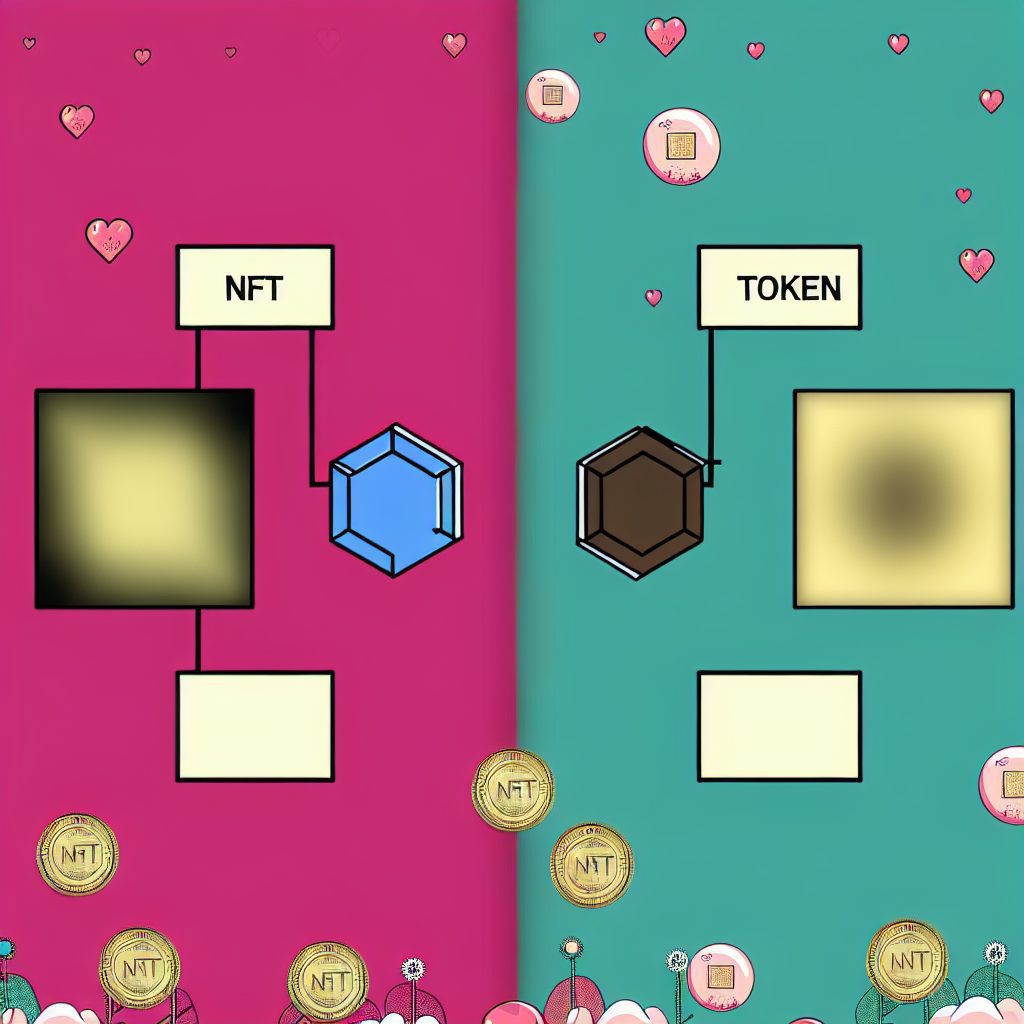The Difference Between NFT and Token
The cryptocurrency landscape is vast and complex, filled with various terms and concepts that can often confuse newcomers and even seasoned investors. Among these terms, NFTs (Non-Fungible Tokens) and tokens are frequently discussed, yet they represent fundamentally different concepts within the blockchain ecosystem. Understanding the distinction between NFTs and tokens is crucial for anyone looking to navigate the world of cryptocurrency effectively.
What is a Token?
A token is a digital asset created on a blockchain that represents a unit of value. Tokens can serve various purposes, including representing assets, granting access to services, or functioning as a medium of exchange. They are typically categorized into two main types: utility tokens and security tokens.
- Utility Tokens: These tokens provide users with access to a product or service within a blockchain ecosystem. For example, Binance Coin (BNB) is a utility token that allows users to pay for trading fees on the Binance exchange.
- Security Tokens: These represent ownership in an asset, such as shares in a company or real estate. They are subject to regulatory oversight and are designed to comply with securities laws. An example is tZERO, which offers security tokens for trading.
Tokens are generally fungible, meaning each token is interchangeable with another of the same type. For instance, one Bitcoin (BTC) is equal to another Bitcoin, making them fungible assets.
What is an NFT?
A Non-Fungible Token (NFT) is a unique digital asset that represents ownership of a specific item or piece of content on the blockchain. Unlike tokens, NFTs are not interchangeable; each NFT has distinct characteristics that make it one-of-a-kind. This uniqueness is what gives NFTs their value, particularly in the realms of art, music, gaming, and collectibles.
- Digital Art: Artists can create and sell digital artwork as NFTs, allowing them to retain ownership and earn royalties on future sales. A notable example is Beeple’s “Everydays: The First 5000 Days,” which sold for $69 million at auction.
- Gaming: In games like Axie Infinity, players can buy, sell, and trade unique creatures as NFTs, creating a vibrant marketplace.
NFTs are built on various blockchain platforms, with Ethereum being the most popular due to its robust smart contract capabilities. Other blockchains like Binance Smart Chain, Flow, and Tezos also support NFTs.
Key Differences Between NFTs and Tokens
While both NFTs and tokens exist on blockchains, their fundamental differences can be summarized as follows:

- Fungibility: Tokens are fungible, meaning they are interchangeable. NFTs are non-fungible, meaning each one is unique.
- Purpose: Tokens can represent various assets or utilities, while NFTs specifically represent ownership of unique items or content.
- Standards: Tokens often adhere to standards like ERC-20 (for fungible tokens) or ERC-721 (for NFTs). The latter defines the unique properties of NFTs.
- Marketplaces: Tokens are typically traded on cryptocurrency exchanges, while NFTs are bought and sold on specialized marketplaces like OpenSea or Rarible.
Use Cases for Tokens
Tokens have a wide range of applications across various industries. Here are some notable use cases:
- Decentralized Finance (DeFi): Tokens are used in DeFi platforms for lending, borrowing, and trading. For instance, Uniswap uses its token, UNI, for governance and liquidity incentives.
- Supply Chain Management: Tokens can represent goods in a supply chain, providing transparency and traceability. Projects like VeChain utilize tokens for this purpose.
- Charity and Fundraising: Tokens can be used to raise funds for charitable causes, allowing donors to track how their contributions are used.
Use Cases for NFTs
NFTs have gained immense popularity, particularly in the art and entertainment sectors. Here are some prominent use cases:
- Digital Collectibles: Platforms like NBA Top Shot allow fans to buy, sell, and trade officially licensed NBA collectible highlights as NFTs.
- Virtual Real Estate: In virtual worlds like Decentraland, users can buy and sell virtual land as NFTs, creating a new market for digital real estate.
- Music and Entertainment: Musicians can release albums as NFTs, providing fans with exclusive content and experiences. For example, Kings of Leon released an album as an NFT, offering special perks to buyers.
Real-World Examples of NFTs and Tokens
To further illustrate the differences between NFTs and tokens, let’s explore some real-world examples:
Tokens in Action
Chainlink (LINK) is a prime example of a utility token that provides real-world data to smart contracts on the blockchain. By using Chainlink, developers can create decentralized applications (dApps) that require external data, such as price feeds or weather information.
Another example is Ripple (XRP), which is designed for cross-border payments. Ripple aims to facilitate fast and low-cost international transactions, making it a valuable token in the financial sector.
NFTs in Action
CryptoPunks are one of the earliest examples of NFTs, consisting of 10,000 unique 24×24 pixel art characters. They have become highly sought after, with some selling for millions of dollars. The popularity of CryptoPunks has paved the way for other NFT projects, such as Bored Ape Yacht Club, which combines art with community engagement.
Challenges and Considerations
Both NFTs and tokens face challenges that potential investors and users should consider:
- Regulatory Issues: The regulatory landscape for tokens and NFTs is still evolving. Security tokens, in particular, must comply with securities laws, which can complicate their issuance and trading.
- Market Volatility: The prices of tokens and NFTs can be highly volatile, leading to significant financial risk for investors.
- Environmental Concerns: The energy consumption of blockchain networks, particularly those using proof-of-work consensus mechanisms, has raised concerns about their environmental impact.
FAQs
What is the main difference between an NFT and a token?
The main difference is that NFTs are non-fungible and represent unique items, while tokens are fungible and can represent various assets or utilities.
Can NFTs be used as currency?
While NFTs can be bought and sold for cryptocurrency, they are not typically used as a currency due to their unique nature. Tokens, on the other hand, can function as a medium of exchange.
Are NFTs a good investment?
Investing in NFTs can be risky due to their volatility and the speculative nature of the market. Potential investors should conduct thorough research before purchasing NFTs.
How do I create an NFT?
To create an NFT, you need to choose a blockchain that supports NFTs (like Ethereum), create a digital asset, and use a platform like OpenSea or Rarible to mint your NFT.
Conclusion
Understanding the difference between NFTs and tokens is essential for anyone looking to engage with the cryptocurrency industry. While both play significant roles in the blockchain ecosystem, their unique characteristics and applications set them apart. Tokens offer fungibility and utility across various sectors, while NFTs provide a way to own and trade unique digital assets.
As the cryptocurrency landscape continues to evolve, staying informed about these distinctions will empower you to make better investment decisions and navigate this exciting space more effectively. For the latest news and updates in the crypto world, consider visiting Bitrabo.
For more insights and discussions, feel free to follow me on X, Instagram, and Threads.
Disclaimer: This article is for informational purposes only and should not be considered financial advice. Always conduct your own research before making investment decisions.
The Crypto Watchlist of the Week 🔎
Subscribe to receive expert-curated projects with real potential—plus trends, risks, and insights that matter. Get handpicked crypto projects, deep analysis & market updates delivered to you.


